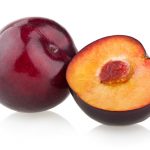 Not only are plums and prunes succulent and desiccated versions of the same fruit, their names are versions of the same word: they both derive from the Greek word for the fruit, proumnon, which became the Latin prunum before splitting into the Old English plume and into the Old French prune. When it emerged in the eighth century, the Old English plume was pronounced to rhyme with broom; in the fifteenth century, however, the word lost its final e and shortened its middle vowel, thus establishing the modern spelling and pronunciation of plum. In contrast, the Old French prune, which English adopted in the mid fourteenth century, never lost its final e and never shortened its middle vowel. As a result of these divergent developments, the close connection of plum and prune has been somewhat obscured. Incidentally, plum is not related to the plumb in expressions such as “I’m plumb tuckered out.” That plumb derives from the plumb line, a lead weight attached to a string and used by engineers to ensure that walls are perfectly vertical (the Latin word for lead is plumbum). Because a plumb line is so utterly straight, the name of the tool came to be used as a synonym for utterly or completely.
Not only are plums and prunes succulent and desiccated versions of the same fruit, their names are versions of the same word: they both derive from the Greek word for the fruit, proumnon, which became the Latin prunum before splitting into the Old English plume and into the Old French prune. When it emerged in the eighth century, the Old English plume was pronounced to rhyme with broom; in the fifteenth century, however, the word lost its final e and shortened its middle vowel, thus establishing the modern spelling and pronunciation of plum. In contrast, the Old French prune, which English adopted in the mid fourteenth century, never lost its final e and never shortened its middle vowel. As a result of these divergent developments, the close connection of plum and prune has been somewhat obscured. Incidentally, plum is not related to the plumb in expressions such as “I’m plumb tuckered out.” That plumb derives from the plumb line, a lead weight attached to a string and used by engineers to ensure that walls are perfectly vertical (the Latin word for lead is plumbum). Because a plumb line is so utterly straight, the name of the tool came to be used as a synonym for utterly or completely.
In the realm of succulent fruits belonging to the esteemed genus Prunus, we encounter a remarkable creation believed to have evolved from the humble sloe. This enchanting entity, known as the plum, has given rise to a vast array of cultivars, numbering in the hundreds, which thrive across the globe. Plum varieties showcase a captivating spectrum of hues, spanning from radiant gold to profound shades of purple, while also exhibiting significant variations in size. Within this diverse assortment, some plums shine as delectable treats for the dessert aficionado, while others boast a culinary prowess that lends itself perfectly to gastronomic transformations. A select few possess the versatility to gracefully fulfill both roles, delighting the palate in whichever way they are employed.
